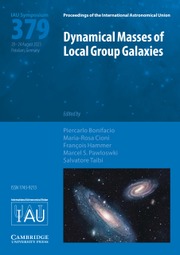No CrossRef data available.
Article contents
An evolved planetary nebula physically associated with the open cluster M37
Published online by Cambridge University Press: 06 October 2025
Abstract
We have found strong evidence that an extended bipolar planetary nebula (PN), lying in the line-of-sight of the Galactic open cluster M37, is actually its physical member. We estimated both the PN physical properties and the properties of its progenitor from cluster studies. The progenitor mass has been found to be around 2.8 M⊙. There are only a handful of such confirmed associations and each of them provides valuable additional data to the initial-to-final-mass relation. The nebula has a major axis of 445 arcsec and a kinematical age of around 80 kyrs -the largest ever determined for a PN- suggesting that PNe in clusters do not dissipate as fast as field PNe.
Information
- Type
- Poster Paper
- Information
- Proceedings of the International Astronomical Union , Volume 19 , Symposium S384: Planetary Nebulae: A Universal Toolbox in the Era of Precision Astrophysics , December 2023 , pp. 405 - 407
- Copyright
- © The Author(s), 2025. Published by Cambridge University Press on behalf of International Astronomical Union
References
Cummings, J. D., Kalirai, J. S., Tremblay, P.-E., Ramirez-Ruiz, E., Choi, J., 2018, ApJ, 866, 21
CrossRefGoogle Scholar
Fragkou, V., Parker, Q. A., Zijlstra, A., Shaw, R., Lykou, F., 2019, MNRAS, 484, 3078
Google Scholar
Fragkou, V., Parker, Q. A., Zijlstra, A. A., Crause, L., Barker, H., 2019, NatAs, 3, 851
Google Scholar
Fragkou, V., Parker, Q. A., Zijlstra, A. A., Vázquez, R., Sabin, L., et al., 2022, ApJL, 935, L35
CrossRefGoogle Scholar
Griggio, M., Bedin, L. R., Raddi, R., Reindl, N., Tomasella, L., et al., 2022, MNRAS, 515, 1841
Google Scholar
Parker, Q. A., Frew, D. J., Miszalski, B., Kovacevic, A. V., Frinchaboy, P. M., et al., 2011, MNRAS, 413, 1835
CrossRefGoogle Scholar
Werner, K., Reindl, N., Raddi, R., Griggio, M., Bedin, L. R., et al., 2023, A&A, 678, A89
Google Scholar


